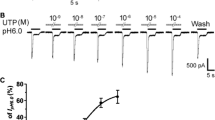In acutely isolated rat primary sensory neurons, the effects of caffeine on GABA receptormediated current (I GABA) were investigated using a whole-cell patch clamp technique. We found that applications of GABA (10-1000 μM) induced inward currents in a concentration-dependent manner; the currents manifested obvious desensitization. Pretreatment with caffeine (0.01-100 μM) suppressed I GABA in a noncompetitive manner; caffeine shifted the concentration–response curve for GABA downwards compared to the control. Theophylline showed a similar and stronger inhibitory effect on I GABA. Isolated application of 1 μM diazepam enhanced I GABA, while pretreatment with 10 μM caffeine and 1 μM diazepam suppressed this current. Intracellular application of the protein kinase A inhibitor H-8 dramatically weakened the inhibitory effect of caffeine on I GABA. Because primary afferent depolarization is related to GABAA receptors, our results suggest that caffeine might antagonize presynaptic inhibitory effects of primary afferents, probably via inhibition of intracellular phosphodiesterase.
Similar content being viewed by others

References
T. Somekawa-Kondo, K. Yamaguchi, Y. Ishitsuka, et al., “Aminophylline, administered at usual doses for rodents in pharmacological studies, induces hippocampal neuronal cell injury under low tidal volume hypoxic conditions in guinea-pigs,” J. Pharm. Pharmacol., 65, No. 1, 102-114 (2013).
N. P. Riksen, P. Smits, and G. A. Rongen, “The cardiovascular effects of methylxanthines,” Handbook Exp. Pharmacol., 200, 413-437 (2011).
H. Uneyama, M. Munakata, and N. Akaike,“Caffeine response in pyramidal neurons freshly dissociated from rat hippocampus,” Brain Res., 604, Nos. 1/2, 24-31 (1993)
C. C. Chou and T. W. Vickroy,“Antagonism of adenosine receptors by caffeine and caffeine metabolites in equine forebrain tissues,” Am. J. Vet. Res., 64, No. 2, 216-224 (2003).
C. W. Hsu, C. S. Wang, and T. H. Chiu,“Caffeine and a selective adenosine A2A receptor antagonist induce sensitization and cross-sensitization behavior associated with increased striatal dopamine in mice,” J. Biomed. Sci., 17, 4 (2010).
M. El Yacoubi, C. Ledent, M. Parmentier, et al., “In vivo labelling of the adenosine A2A receptor in mouse brain using the selective antagonist [3H]SCH 58261,” Eur. J. Neurosci., 14, No. 9, 1567-1570 (2001).
O. Pauvert, C. Lugnier, T. Keravis, et al.,“Effect of sildenafil on cyclic nucleotide phosphodiesterase activity, vascular tone and calcium signaling in rat pulmonary artery,” Br. J. Pharmacol., 139, No. 3, 513-522 (2003).
F. A. Belibi, D. P. Wallace, T. Yamaguchi, et al., “The effect of caffeine on renal epithelial cells from patients with autosomal dominant polycystic kidney disease,” J. Am. Soc. Nephrol., 13, No. 11, 2723-2729 (2002).
D. Shi, W. L. Padgett, and J. W. Daly,“Caffeine analogs: effects on ryanodine-sensitive calcium-release channels and GABAA receptors,” Cell. Mol. Neurobiol., 23, No. 3, 331-347 (2003).
S. S. Kang, K. S. Han, B. M. Ku, et al., “ Caffeinemediated inhibition of calcium release channel inositol 1,4,5-trisphosphate receptor subtype 3 blocks glioblastoma invasion and extends survival,” Cancer Res., 70, No. 3, 1173-1183 (2010).
C. Yang, S. Franciosi, and R. E. Brown, “Adenosine inhibits the excitatory synaptic inputs to basal forebrain cholinergic, GABAergic, and parvalbumin neurons in mice,” Front. Neurol., 20, No. 4, 77 (2013)
J. A. Ribeiro and A. M. Sebastião, “Caffeine and adenosine,” J. Alzheimer´s Dis., 20, Suppl. 1, S3-S15 (2010)
Q. X. Chen, A. Stelzer, A. R. Kay, et al., “GABAA receptor function is regulated by phosphorylation in acutely dissociated guinea-pig hippocampal neurones,” J. Physiol., 420, 207-221 (1990).
M. Gyenes, Q. Wang, T. T. Gibbs, et al., “Phosphorylation factors control neurotransmitter and neuromodulator actions at the gamma-aminobutyric acid type A receptor,” Mol. Pharmacol., 46, No. 3, 542-549 (1994).
C. S. Huang, J. Y. Ma, W. Marszalec, et al., “Effects of the nootropic drug nefiracetam on the GABAA receptorchannel complex in dorsal root ganglion neurons,” Neuropharmacology, 35, Nos. 9/10, 1251-1261 (1996)
N. M. Porter, R. E. Twyman, M. D. Uhler, et al., “Cyclic AMP-dependent protein kinase decreases GABAA receptor current in mouse spinal neurons,” Neuron, 5, No. 6, 789-796 (1990)
N. Gonçalves, A. T. Simões, R. A. Cunha, et al., “Caffeine and adenosine A(2A) receptor inactivation decrease striatal neuropathology in a lentiviral-based model of Machado-Joseph disease,” Ann. Neurol., 73, No. 5, 655-666 (2013).
N. Vanattou-Saïfoudine, B. Behan, and A. Harkin, “Dopamine D1 receptor-mediated intracellular responses in the hypothalamus after co-administration of caffeine with MDMA,” Basic Clin. Pharmacol. Toxicol., 110, No. 3, 283-289 (2012).
K. M. Capiotti, F. P. Menezes, L. R. Nazario, et al., “Early exposure to caffeine affects gene expression of adenosine receptors, DARPP-32 and BDNF without affecting sensibility and morphology of develo** zebrafish (Danio rerio),” Neurotoxicol. Teratol., 33 No. 6, 680-685 (2011).
S. Sharmin, H. Guan, A. S. Williams, et al., “Caffeine reduces 11β-hydroxysteroid dehydrogenase type 2 expression in human trophoblast cells through the adenosine A(2B) receptor,” PLoS One, No. 6, e3808 (2012).
R. L. Weir and R. E. Hruska,“ Interaction between methylxanthines and the benzodiazepine receptor,” Arch. Int. Pharmacodyn. Ther., 265, No. 1, 42-48 (1983).
F. R. da Silva , R. Lazzarini, L. C. de Sá-Rocha, et al., “Effects of acute and long-term diazepam administrations on neutrophil activity: a flow cytometric study,” Eur. J. Pharmacol., 478, Nos. 2/3, 97-104 (2003)
H. Z. Hu and Z. W. Li,“Modulation by adenosine of GABA-activated current in rat dorsal root ganglion neurons,” J. Physiol., 501, 67-75 (1997).
M. Inoue, Y. Oomura, T. Yakushiji, et al., “Intracellular calcium ions decrease the affinity of the GABA receptor,” Nature, 324, No. 6093, 156-158 (1986)
Y. C. Yu, L. H. Cao, X. L. Yang, et al.,“ Modulation by brain natriuretic peptide of GABA receptors on rat retinal ON-type bipolar cells,” J. Neurosci., 26, No. 2, 696-707 (2006).
Author information
Authors and Affiliations
Corresponding authors
Rights and permissions
About this article
Cite this article
Yang, J.Y., Yang, G., Ren, J. et al. Caffeine Suppresses GABA Receptor-Mediated Current in Rat Primary Sensory Neurons via Inhibition of Intracellular Phosphodiesterase. Neurophysiology 47, 108–114 (2015). https://doi.org/10.1007/s11062-015-9506-1
Received:
Published:
Issue Date:
DOI: https://doi.org/10.1007/s11062-015-9506-1


